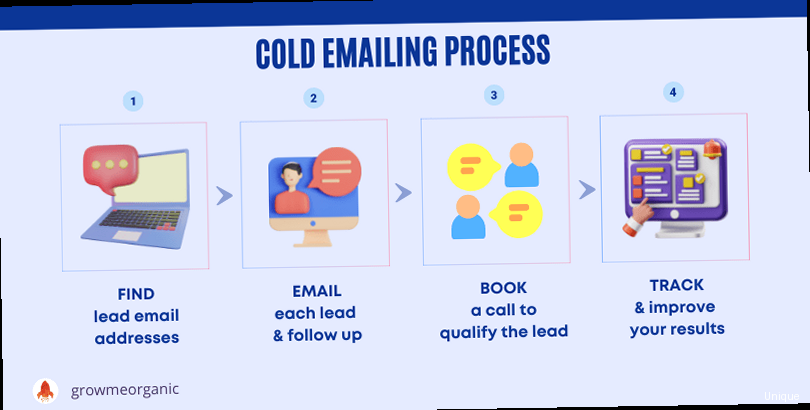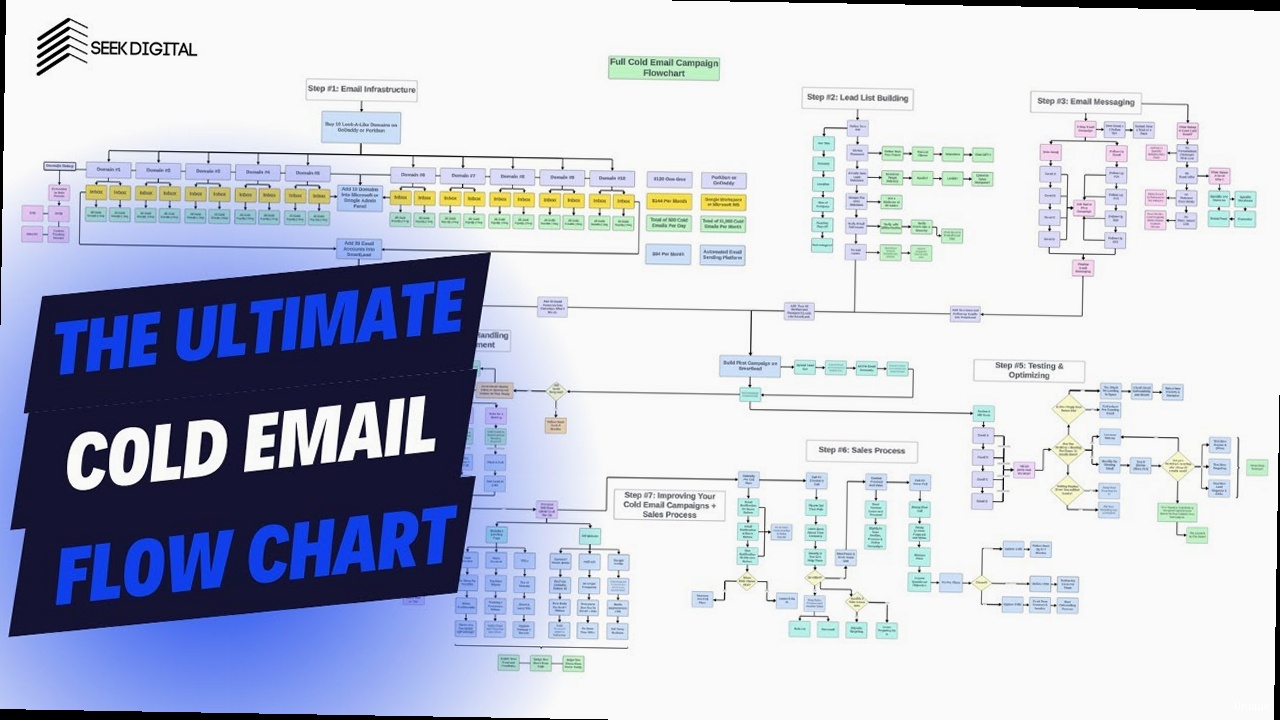Is Cold Emailing Effective in 2024? A Data-Driven Approach
Cold emailing, the practice of sending unsolicited emails to potential customers, has been a marketing strategy for decades. But in today’s digital landscape, saturated in spam and governed by increasingly strict privacy regulations, is cold emailing still a viable and effective tool? This article dives deep into the effectiveness of cold emailing in 2024, focusing on deliverability strategies and how to avoid the spam folder to achieve meaningful engagement and conversions. We’ll explore specific technical steps and best practices to optimize your cold email campaigns for success.
Table of Contents:
- Understanding Deliverability Challenges in Cold Email
- Technical Setup for Optimal Deliverability
- Crafting Engaging Email Content that Bypasses Spam Filters
- Tracking and Optimizing Cold Email Campaigns for Maximum ROI
Understanding Deliverability Challenges in Cold Email

The biggest hurdle in cold emailing is undoubtedly deliverability. Your meticulously crafted email means nothing if it lands in the spam folder or, worse, is blocked entirely. Understanding the factors that influence deliverability is crucial before launching any cold email campaign. This includes understanding Sender Reputation, IP Warming, SPF, DKIM, and DMARC protocols. Ignoring these can drastically reduce your chances of reaching your target audience.
Sender Reputation: The Foundation of Deliverability
Your sender reputation is like a credit score for your email sending domain and IP address. Email providers use it to assess your legitimacy. A poor reputation significantly increases the likelihood of your emails being flagged as spam. Factors contributing to a bad reputation include high bounce rates, spam complaints, and blacklisting. Monitoring your sender reputation is critical. Tools like Sender Score (senderscore.org) can provide valuable insights.
Example 1: Checking Sender Reputation with Sender Score
Visit https://senderscore.org/ and enter your sending IP address or domain to get a score from 0-100. A score above 80 is generally considered good. If your score is low, investigate potential issues like spam complaints or being listed on blacklists.
Example 2: Investigating Blacklist Status
Use a multi-RBL (Real-time Blackhole List) checker like MXToolbox (mxtoolbox.com/blacklists.aspx) to see if your IP address or domain is listed on any blacklists. If you are, you will need to take steps to get delisted, usually by contacting the blacklist provider and addressing the underlying issues that led to the listing (e.g., reducing bounce rates).
# Example of checking blacklist status using dig command (Linux/macOS)
dig +short yourdomain.com @dnsbl.sorbs.net
If the command returns an IP address, your domain is listed on the SORBS blacklist. This requires immediate action to resolve.
The Importance of IP Warming
If you’re using a new IP address for sending emails, you can’t just start blasting out thousands of messages. Email providers will see this as suspicious activity and likely block you. IP warming involves gradually increasing the volume of emails you send over a period of weeks or even months. This establishes a positive sending history and builds trust with email providers.
Example 3: IP Warming Schedule
| Day | Emails Sent |
|---|---|
| Day 1-3 | 50 |
| Day 4-7 | 100 |
| Day 8-14 | 250 |
| Day 15-21 | 500 |
| Day 22-30 | 1000 |
This is just an example; you should adjust the schedule based on your specific needs and the responsiveness of your recipients. Monitor your bounce rates and engagement metrics carefully during the warming process.
Example 4: Prioritizing Engagement During IP Warming
During IP warming, send emails to your most engaged subscribers first. These are people who have previously interacted with your emails. Positive engagement (opens, clicks, replies) signals to email providers that your emails are valuable, which helps build a positive sender reputation.
Authentication Protocols: SPF, DKIM, and DMARC
SPF (Sender Policy Framework), DKIM (DomainKeys Identified Mail), and DMARC (Domain-based Message Authentication, Reporting & Conformance) are authentication protocols that help verify that an email is actually sent from the domain it claims to be from. Implementing these protocols is essential for improving deliverability and preventing spoofing.
Example 5: Setting up SPF Record
An SPF record is a TXT record added to your domain’s DNS settings. It specifies which mail servers are authorized to send emails on behalf of your domain.
# Example SPF record allowing mail from Google Workspace and your web server
"v=spf1 include:_spf.google.com a mx ~all"
Replace `_spf.google.com` with the appropriate SPF record for your email service provider. The `a` and `mx` mechanisms allow mail from the server specified in your domain’s A and MX records, respectively. The `~all` mechanism specifies a softfail, meaning emails that don’t match the SPF record are still accepted but marked as suspicious. For stricter security, you can use `-all` (fail).
Example 6: Setting up DKIM Record
DKIM uses a digital signature to verify the authenticity of an email. Your email server signs the email with a private key, and the recipient’s server verifies the signature using a public key stored in your DNS records.
The exact steps for generating and installing a DKIM key vary depending on your email service provider. Typically, you’ll generate a key pair, add the public key as a TXT record in your DNS settings, and then configure your email server to sign outgoing emails with the private key.
# Example DKIM TXT record
"v=DKIM1; k=rsa; p=MIGfMA0GCSqGSIb3DQEBAQUAA4GNADCBiQKBgQD....your_public_key....IDAQAB"
Replace `…your_public_key…` with your actual public key. Make sure to copy the entire key without any spaces or line breaks.
Example 7: Setting up DMARC Record
DMARC builds on SPF and DKIM by providing instructions to recipient mail servers on what to do with emails that fail SPF and DKIM checks. It also allows you to receive reports about authentication failures, helping you identify and address potential spoofing attempts.
# Example DMARC TXT record
"_dmarc.yourdomain.com. IN TXT "v=DMARC1; p=none; rua=mailto:dmarc-reports@yourdomain.com; ruf=mailto:dmarc-forensic@yourdomain.com; adkim=r; aspf=r; fo=1""
Explanation of the record components:
- `v=DMARC1`: Specifies the DMARC version.
- `p=none`: Specifies the policy for emails that fail SPF and DKIM checks. `none` means take no action (monitor mode). `quarantine` means mark as spam. `reject` means reject the email. Start with `none` and gradually move to `quarantine` or `reject` as you gain confidence in your DMARC configuration.
- `rua=mailto:dmarc-reports@yourdomain.com`: Specifies the email address to send aggregate reports to.
- `ruf=mailto:dmarc-forensic@yourdomain.com`: Specifies the email address to send forensic reports to (samples of failing emails).
- `adkim=r`: Alignment mode for DKIM (relaxed).
- `aspf=r`: Alignment mode for SPF (relaxed).
- `fo=1`: Generate forensic reports if SPF and/or DKIM fail.
Expert Tip: Regularly monitor your DMARC reports to identify and address any authentication issues. This will help you protect your domain from spoofing and improve your deliverability.
Technical Setup for Optimal Deliverability

Beyond the fundamental authentication protocols, several technical configurations can significantly impact your cold email deliverability. This section focuses on setting up a dedicated sending domain, configuring reverse DNS (rDNS), and utilizing email testing tools.
Dedicated Sending Domain: Separating Reputation
Using your primary domain for cold emailing is risky. If your cold emails are flagged as spam, it can damage the reputation of your primary domain, impacting your regular business communications. A dedicated sending domain (e.g., `marketing.yourdomain.com` instead of `yourdomain.com`) isolates the reputation risk. If the sending domain’s reputation is affected, it won’t impact your primary domain.
Example 1: Setting up a Subdomain
Create a new subdomain through your domain registrar’s control panel. The process varies depending on the registrar, but it generally involves adding an “A” record that points the subdomain to the IP address of your sending server. Also create MX, SPF, DKIM and DMARC records for the new subdomain. Treat the subdomain like a completely separate domain for email sending purposes.
Example 2: Warming Up Your Sending Subdomain
Just like a new IP address, a new subdomain requires warming up. Start with a very low sending volume and gradually increase it over time. Monitor your deliverability metrics closely and adjust your sending schedule as needed.
Reverse DNS (rDNS): Confirming Identity
Reverse DNS (rDNS) maps an IP address to a domain name. It’s the opposite of a regular DNS lookup, which maps a domain name to an IP address. Setting up rDNS is crucial because it helps verify that the IP address sending emails is authorized to send on behalf of the domain. Many email providers reject emails from servers without proper rDNS records.
Example 3: Configuring rDNS
You typically configure rDNS through your hosting provider or the provider that assigned you the IP address. The process involves contacting their support team and requesting that they set up a PTR record (Pointer record) that maps your IP address to your sending domain or subdomain.
# Example request to hosting provider
"Please configure reverse DNS for IP address 192.0.2.1 to point to marketing.yourdomain.com."
Example 4: Verifying rDNS Configuration
You can use the `dig` command (Linux/macOS) or online tools to verify that your rDNS is configured correctly.
# Example command to check rDNS
dig -x 192.0.2.1
The output should show the PTR record pointing to your sending domain.
Email Testing Tools: Pre-Flight Checks
Before launching your cold email campaign, use email testing tools to assess your email’s deliverability and identify potential issues. These tools analyze your email content, headers, and authentication settings to provide insights into how it’s likely to be received by different email providers.
Example 5: Using Mail-Tester
Mail-Tester is a free and easy-to-use tool. It provides a unique email address that you can send your email to. Mail-Tester then analyzes your email and provides a score (out of 10) along with detailed feedback on any issues it finds.
Example 6: Using GlockApps
GlockApps is a more comprehensive email testing tool that provides deliverability reports from multiple email providers. It allows you to see how your email is placed in the inbox (or spam folder) at different email providers around the world. This provides valuable insights into how your email is likely to be received by your target audience.
Expert Tip: Pay close attention to the feedback from email testing tools and address any issues before launching your campaign. This could include fixing broken links, optimizing your email content, or improving your authentication settings. It’s better to find and fix these issues before sending your email to a large audience.
Crafting Engaging Email Content that Bypasses Spam Filters
Even with perfect technical setup, poorly written or generic email content will land you straight in the spam folder. Email content is scrutinized by spam filters and human reviewers. Focus on crafting personalized, valuable, and engaging content that resonates with your target audience and avoids triggering spam filters. This section focuses on personalization, avoiding spam trigger words, and optimizing email structure.
Personalization: Beyond Just Names
Generic greetings and boilerplate text are a surefire way to get your email ignored. Personalization goes beyond simply inserting the recipient’s name. It involves tailoring your message to their specific interests, needs, and pain points. Research your prospects and demonstrate that you understand their unique situation.
Example 1: Personalizing Based on Industry
Instead of a generic opening, mention a specific challenge or trend in their industry.
“I noticed that many companies in the [Industry Name] sector are struggling with [Specific Challenge]. I have some insights on how to address this based on my experience with similar businesses.”
Example Personalized Opening
Example 2: Referencing Recent Activity
If the prospect recently published an article, spoke at a conference, or appeared in the news, mention it in your email. This shows that you’ve done your research and are genuinely interested in their work.
“I enjoyed your recent article on [Topic]. Your insights on [Specific Point] were particularly insightful. I have a related idea that I thought you might find interesting.”
Referencing Recent Activity
Avoiding Spam Trigger Words: A Careful Balancing Act
Certain words and phrases are commonly associated with spam and can trigger spam filters. While there’s no definitive list of spam trigger words, it’s best to avoid overly promotional language, guarantees, and phrases that sound too good to be true. Focus on clear, concise, and natural language.
Example 3: Replacing Spam Trigger Words
| Spam Trigger Word | Alternative |
|---|---|
| Free | Complimentary |
| Guarantee | Commitment |
| Urgent | Important |
| Best Price | Competitive Pricing |
| Click Here | Learn More |
Example 4: Balancing Value and Sales Language
Instead of focusing solely on selling your product or service, highlight the value you can provide to the prospect. Explain how you can help them solve a problem, achieve a goal, or improve their business.
Optimizing Email Structure: Readability and Engagement
The structure of your email plays a crucial role in both readability and engagement. Use short paragraphs, clear headings, and bullet points to make your email easy to scan and digest. Include a clear call to action (CTA) that tells the recipient what you want them to do next.
Example 5: Email Structure Template
- Subject Line: Compelling and personalized.
- Greeting: Personalized and relevant.
- Introduction: Briefly introduce yourself and your company.
- Value Proposition: Explain how you can help the recipient.
- Social Proof (Optional): Mention relevant clients or case studies.
- Call to Action: Clear and specific.
- Closing: Professional and courteous.
Example 6: Call to Action Examples
- “Would you be open to a brief call next week to discuss this further?”
- “I’ve attached a case study that demonstrates how we helped a similar company achieve [Specific Result]. Would you like to take a look?”
- “If you’re interested in learning more, I’d be happy to schedule a demo.”
Expert Tip: Write as you speak. Use a conversational tone and avoid jargon or overly formal language. Read your email aloud before sending it to ensure it sounds natural and engaging.
Tracking and Optimizing Cold Email Campaigns for Maximum ROI
The effectiveness of cold emailing hinges not just on sending emails, but also on meticulously tracking their performance and optimizing your approach based on the data. Without proper tracking and optimization, you’re essentially flying blind. This section focuses on essential metrics, A/B testing, and refining your target audience.
Essential Metrics: Measuring Success
Several key metrics provide insights into the effectiveness of your cold email campaigns. Tracking these metrics allows you to identify what’s working and what’s not, enabling you to make data-driven adjustments to improve your results.
- Open Rate: The percentage of recipients who opened your email. A low open rate could indicate issues with your subject line or sender reputation.
- Click-Through Rate (CTR): The percentage of recipients who clicked on a link in your email. A low CTR suggests that your email content isn’t engaging or relevant to your audience.
- Bounce Rate: The percentage of emails that couldn’t be delivered. High bounce rates can damage your sender reputation.
- Reply Rate: The percentage of recipients who replied to your email. This is a direct indicator of engagement and interest.
- Conversion Rate: The percentage of recipients who took the desired action (e.g., scheduling a call, downloading a resource, making a purchase). This is the ultimate measure of your campaign’s success.
Example 1: Tracking Metrics with Google Analytics
Use UTM parameters (Urchin Tracking Module) to track clicks from your emails in Google Analytics. Add UTM parameters to the URLs in your email to identify the source, medium, and campaign.
# Example URL with UTM parameters
https://www.example.com/landing-page?utm_source=coldemail&utm_medium=email&utm_campaign=leadgeneration
Then in Google Analytics, navigate to *Acquisition > Campaigns > All Campaigns* to see the performance of your cold email campaigns.
Example 2: Using Email Marketing Platform Analytics
Most email marketing platforms (e.g., Mailchimp, Sendinblue, Lemlist) provide built-in analytics dashboards that track open rates, CTR, bounce rates, and other key metrics. Utilize these dashboards to monitor your campaign performance in real-time.
A/B Testing: Optimizing Elements
A/B testing involves testing different versions of your email to see which performs better. Test different subject lines, email content, CTAs, and sending times to identify what resonates most with your target audience.
Example 3: A/B Testing Subject Lines
Create two versions of your email with different subject lines. Send each version to a small subset of your audience and track the open rates. The subject line with the higher open rate is the winner and should be used for the rest of your campaign.
| Subject Line A | Subject Line B |
|---|---|
| Increase Your Sales by 20% | [Prospect Name], Quick Question About Sales |
Example 4: A/B Testing Call to Action
Test different CTAs to see which motivates recipients to take action. Try different wording, button colors, and placement to optimize your conversion rate.
- Version A: “Schedule a Call”
- Version B: “Talk to an Expert”
Refining Your Target Audience: Laser Focus
Cold emailing is most effective when you’re targeting a specific and well-defined audience. Continuously refine your targeting criteria based on the results of your campaigns. Identify the characteristics of the recipients who are most likely to engage with your emails and focus your efforts on reaching similar prospects.
Example 5: Analyzing Conversion Data
Analyze the demographics, job titles, and company sizes of the recipients who converted from your cold email campaigns. Look for patterns and trends that can help you identify your ideal customer profile.
Example 6: Using LinkedIn Sales Navigator
LinkedIn Sales Navigator allows you to filter prospects based on a wide range of criteria, including industry, job title, company size, location, and more. Use Sales Navigator to identify and target the most relevant prospects for your cold email campaigns.
Expert Tip: Don’t be afraid to experiment with different approaches. Cold emailing is an iterative process. Continuously test, track, and optimize your campaigns to improve your results over time.
